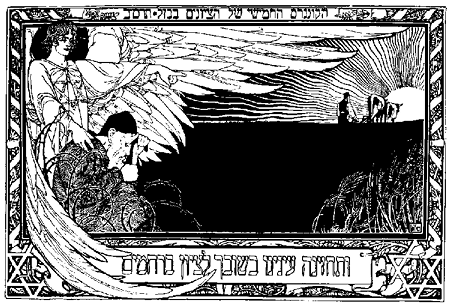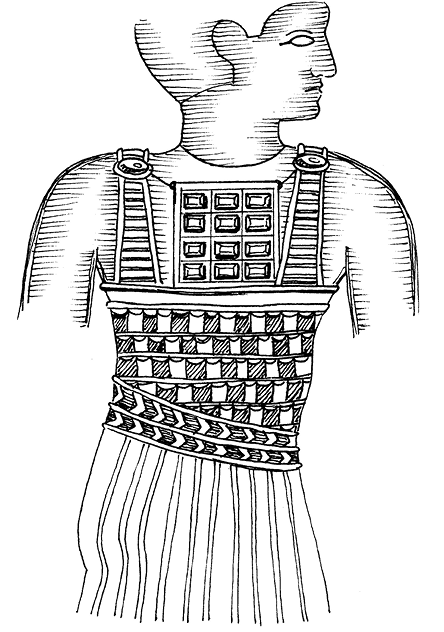The Encyclopedia of Jewish Myth, Magic and Mysticism: Second Edition (2016)
U

Unclean Spirits or Impure Spirits: (![]() /Ruchei Tamei). Evil spirits often linked to the priestly purity system (Zech. 13:2). ritual laxness invites attack by these spirits, which inhabit privies, foods, liquids, beds, and even hands contaminated by tamei, ritual impurity (Kid. 72a; Ber. 62b; Zohar I:83a, 184b). They also strike while one sleeps , through inducing nocturnal emissions that render a person impure (Shab. 109a; Zohar I:10b; Zohar III:67a). Since Death also has strong associations with ritual impurity, a few texts hint that they may be spirits of the dead (Num. R. Chukkat 19:8; 11Q11; Sanh. 65b), but most texts treat them as demons.
/Ruchei Tamei). Evil spirits often linked to the priestly purity system (Zech. 13:2). ritual laxness invites attack by these spirits, which inhabit privies, foods, liquids, beds, and even hands contaminated by tamei, ritual impurity (Kid. 72a; Ber. 62b; Zohar I:83a, 184b). They also strike while one sleeps , through inducing nocturnal emissions that render a person impure (Shab. 109a; Zohar I:10b; Zohar III:67a). Since Death also has strong associations with ritual impurity, a few texts hint that they may be spirits of the dead (Num. R. Chukkat 19:8; 11Q11; Sanh. 65b), but most texts treat them as demons.
The rabbinic attitude toward these spirits at times parallels contemporary attitudes toward hygiene, even to the extent that authorities taught that such spirits “infect” the Body by entering through orifices and membranes. Concern about ruchei tamei may have had a role in shaping the custom of hand washing after leaving a cemetery, but there is no text known that directly links the two (Shab. 108b; Tosafot on Yoma 77b and Chul. 107b; Orah Chayyim 4.3, 10). SEE DEMONS; PURITY OR PURIFICATION.
Unicorn: SEE RE'EM.
Unleavened Bread: (![]() /Matzah). A large, cracker-like wafer that is eaten throughout the holiday of Passover in place of risen Bible. It is eaten to commemorate both the slavery and liberation our ancestor experienced. Matzah is made using only specially supervised (keeping it free from exposure to airborne yeast) wheat and water. It is then baked precisely eighteen minutes (the number symbolizing life).
/Matzah). A large, cracker-like wafer that is eaten throughout the holiday of Passover in place of risen Bible. It is eaten to commemorate both the slavery and liberation our ancestor experienced. Matzah is made using only specially supervised (keeping it free from exposure to airborne yeast) wheat and water. It is then baked precisely eighteen minutes (the number symbolizing life).
It is a symbol of ritual and spiritual purity; Jews eat matzah free of leaven just as they must free themselves of the “leaven” of ego, sin, and old habits. It is also a symbol of paradox: it simultaneously symbolizes slavery and freedom. At the Seder, three pieces of matzah are prominently displayed, reminding Jews of both the three biblical classes of Jews (priest, Levite, and Israelite) and the three epochs (the Garden of Eden, historic time, and the time of the Messiah).
One aspect of unleavened bread that has particular occult symbolism is the Afikoman. The Afikoman is one-half of a matzah wafer that is publicly broken, only to be hidden away during the Seder. Children must then find it or steal it from the holder in order for the Seder to continue. Originally intended as a pedagogical tool to keep the attention of children during the ceremony, by the Middle Ages the Afikoman became a symbol of the occult and started to be used as an amulet against the evil eye. Customs include preserving a piece at home for good luck, while some may actually carry crumbs of the Afikoman in their coat pockets. Pregnant women will sometimes keep a piece of Afikoman nearby to ensure an easy labor. According to one tradition, an Afikoman kept seven years can avert a flood or other natural disaster.1
1. Trachtenberg, Jewish Magic and Superstition, 134, 295.
Uraltes Chymisches Werck: “Arcane Chemical Work.” A treatise on alchemy credited to Abraham Eleazar, probably composed in the late 14th or early 15th century.
Uriel: (![]() ). “God Is My Light.” Uriel is one of the four princely angels (Sar ha-Panim) that surround [or form] the Throne of Glory>:
). “God Is My Light.” Uriel is one of the four princely angels (Sar ha-Panim) that surround [or form] the Throne of Glory>:
As the Holy One blessed be He created four winds and four banners, so also did He make four angels to surround His Throne—Michael, Gabriel, Uriel and Raphael. Michael is on its right, next to the tribe of Reuben; Uriel on its left, next to the tribe of Dan, which was in the north; Gabriel in front, next to the tribe of Judah, also Moses and Aaron, who were in the east; and Raphael in the rear, next to the tribe of Ephraim which was in the west … (Num. R. 2:10. Also PdRE 4)
Though this text says he is the angel of the “north,” in fact, there is no consensus within the tradition as to Uriel’s exact position. Other sources claim he is the angel of the south. One text states he stands in front of the Throne of Glory, another text claims he is behind the Throne (Malachei Elyon).
He is first mentioned by name in I Enoch (chapters 9; 19-20), though he does not appear in a later angelic list in that same book. He is identified as the angel who revealed the secrets of the true, celestial calendar to Enoch, counteracting the impure lunar calendar given to humanity by the fallen angels (I Enoch 33, 80). In II Esdras he brings God’s message of rebuke to Ezra (4:1). He appears regularly in medieval angelic lists (PR 46; Num. R. 2:10; Mid. Konen).
Uriel is regarded by some to the Sar ha-Torah, the Prince of the Torah:
Why was he named Uriel? Because of the Torah, the Prophets and the Writings by means of which the Blessed Holy One, atones for sins and gives light to Israel. (Num. R. 2:10)
He is also the patron angel of Jerusalem (4 Ezra 10).

May Our Eyes Envision by E. M. Lilien
He has control over earthquakes and thunder. In the medieval aggadah Gedulat Moshe he is described as being made entirely from hail. He could also take on the form of an eagle. Midrash Aggadah claims he was the avenging force God sent against Moses for failing to circumcise his son Gershom (Ex. 4:14). He announced the birth of Samson.
In the Zohar, he is identified with the lion-faced angel in Ezekiel’s chariot. In lion form, Uriel would descend and consume the sacrifices on the altar of the Temple (I:6b).
Uriel is one of the four guardian angels invoked for protection while sleeping in the bedtime ritual of K’riat Sh’ma al ha-Mitah. SEE SAR HA-PANIM.
Urim and Thummim: (![]() ). A method of divination that was worn as part of the priestly garments (Ex. 28; Num. 27; 1 Sam. 28). The meaning of the names are uncertain, with the translations “Light and Perfection,” “Oracle and Command,” or “Cursed and Innocence” being proposed for a variety of reasons based on biblical Hebrew or cognate phrases from surrounding languages.
). A method of divination that was worn as part of the priestly garments (Ex. 28; Num. 27; 1 Sam. 28). The meaning of the names are uncertain, with the translations “Light and Perfection,” “Oracle and Command,” or “Cursed and Innocence” being proposed for a variety of reasons based on biblical Hebrew or cognate phrases from surrounding languages.
Equally little is truly known about the appearance and operation of the Urim and Thummim. The Rabbis understood the Urim and Thummim to be part of the breastplate of the High priest and that its oracular function came from light shining through the twelve gemstones mounted on the breastplate (PdRE 38). This was achieved by having a plate inscribed with the Tetragrammaton inserted behind the gemstone mounts. Supernal light radiating from the divine name would illuminate different stones. Since each stone was inscribed with the names of the twelve tribes, the Talmud teaches that it functioned as a kind of Ouija board, with messages being spelled on the Urim and Thummim for the High Priest. In Pirke de-Rabbi Eliezer, it is taught that the stone representing a tribe would glow if the tribe was involved in a transgression, but then the diviner would have to discern the specifics himself (38). Some believe the Urim were the lights, while the Thummim was a device or code that helped in interpreting the message.
Other interpreters suggest that the Urim and Thummim were separate objects that were both kept in a pouch of the breastplate. In the Bible, one individual who made a counterfeit breastplate for his personal cult substituted terafim for the Urim and Thummim (Judg. 17-18; Hos. 3:4). This is a tantalizing but frustrating bit of data. Because we also know so little about the terafim, the association of the two objects does not shed much light on either, no pun intended. The best evidence is that the two may have both been made of light-reflecting stone; Mesopotamian sources also mention an elmeshu stone used by the gods for oracular purposes.
The context for its mention in Scripture indicates the Urim and Thummim was only used for questions of grave importance, usually connected to the function of the state, such as whether and when to go to war, though there is one passage in Numbers that hints at the possibility it was used for more mundane questions, such as resolving difficult legal questions. While it is not mentioned by name, Joshua may have determined who violated God’s decree of proscription at Jericho by means of the Urim and Thummim (Josh. 6-7). The answers given by the device that were recorded in the Bible were full sentences, suggesting either that the device was an aid to Prophecy, but did not operate apart from prophecy, or that the Rabbis were correct in their claim that it spelled out messages from the letters on the breastplate.
Mention of the Urim and Thummim ceases early in the history of Israel, indicating that it was no longer in use at the rise of classical prophecy (8th century BCE). There is some indication that it was reintroduced briefly during the Persian period, but it again quickly disappears from the records.1 Post-biblical sources offer numerous elaborations on the history and operation of the Urim and Thummim, but many of the sources contradict each other, making it difficult to fix on any as a legitimate tradition (Dead Sea Scrolls 4Q376; 4QpIsa; Antiquities 3:8; Yoma 73b; Ex. R. 47; Sifrei Num. 141; Targum Jonathan to Ex. 28; Zohar II:234b; Ramban on Ex. 28). The Urim and Thummim have also become part and parcel of Western occult lore; Joseph Smith, for example, claimed to have used the Urim and Thummim to read “Reformed Egyptian” language of the golden book given him by the angel Moroni. The seal of Yale University also contains a reference to them.
1. V. A. Hurowitz, “True Light on the Urim and Thummim,” Jewish Quarterly Review 88, Nos. 3-4 (Jan.-April 1998), 263-74; also see C. Van Dam, The Urim and Thummim: A Means of Revelation in Ancient Israel (Winona Lake, IN: Eisenbrauns, 1997).

Twelve-panel breastplate from Egyptian wall painting
Urine: Urine is used in magical formulae and healing remedies (Shab. 109b).
Ushpizin: (![]() ). “Guests.” The spiritual or ghostly guests welcomed into the festive hut during the holiday of Sukkot. It is considered a great Tikkun, a great act of healing and rectification to have living souls share hospitality during the holiday of Sukkot. But ushpizin do not have to be alive. Jewish mystical tradition teaches Jews should summon the spirits of the ancestral dead to the sukkah. The ritual first emerged among the Kabbalists of 16th-century Safed. In the traditional explanations of this ritual, there is no sense that this is merely a symbolic act:
). “Guests.” The spiritual or ghostly guests welcomed into the festive hut during the holiday of Sukkot. It is considered a great Tikkun, a great act of healing and rectification to have living souls share hospitality during the holiday of Sukkot. But ushpizin do not have to be alive. Jewish mystical tradition teaches Jews should summon the spirits of the ancestral dead to the sukkah. The ritual first emerged among the Kabbalists of 16th-century Safed. In the traditional explanations of this ritual, there is no sense that this is merely a symbolic act:
When a person sits in his Sukkah the Shekhinah spreads its wings over it from above and then Avraham together with the other five Tzadikim make their dwelling with him. Rabba Abba said, “Abraham, five righteous ones, and King David make their dwelling with him.” (Zohar III:103b)
These represent the seven days of Creation, as well as the seven lower sefirot. The sukkah serves as a kind of liminal zone between the physical and spiritual realms. The prayer of summoning is as follows:
May it be Your will, Lord my God and God of my fathers, to send Your presence to dwell in our midst and to spread over us the sukkah of Your peace, to encircle us with the majesty of Your pure and holy radiance. Give sufficient bread and water to all who are hungry and thirsty. Give us many days to grow old upon the earth, the holy earth, that we may serve You and revere You. Blessed by Adonai forever—amen, amen. I invite to my meal the exalted guests—Abraham, Isaac, Jacob, Joseph, Moses, Aaron and David.
There are seven spirits, one for each day of the biblical observance. The 16th-century Italian mystic Menachem Azariah of Fanon also associated the seven “lower” sefirot with the seven prophetesses the Talmud enumerates: Sarah, Miriam, Devorah, Hannah, Abigail, Huldah, and Esther. A different one of these guests is invited for each night of the seven nights of the holiday, and the evening is spent expounding on the virtues and the spiritual significance of that night’s visitor (Suk. 54b; Zohar II:256a; Zohar III:103b-104a). SEE ANCESTORS; HOSPITALITY; PATRIARCHS AND MATRIARCHS; RIGHTEOUS, THE
Uzza: (![]() ). Princely and guardian angels of the Egyptians (BhM 1:39). In other traditions, he and Azazel opposed the creation of humanity. They in time fell in love with mortal women, producing demonic offspring from those couplings. They were punished by being chained to the Mountains of Darkness, yet from there they continue to wreak mischief (Yoma 67b; Aggadat Bereshit; PdRE 22; Zohar I:9b). SEE FALLEN ANGELS; MOUNTAIN.
). Princely and guardian angels of the Egyptians (BhM 1:39). In other traditions, he and Azazel opposed the creation of humanity. They in time fell in love with mortal women, producing demonic offspring from those couplings. They were punished by being chained to the Mountains of Darkness, yet from there they continue to wreak mischief (Yoma 67b; Aggadat Bereshit; PdRE 22; Zohar I:9b). SEE FALLEN ANGELS; MOUNTAIN.